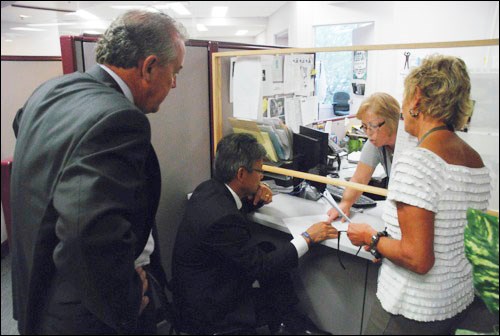Prairie North Health Region had a chance to show off a new electronic surgical information system now in place at the hospital,
The system, described as an electronic system that streamlines the process for patients and staff, is now in operation at both Battlefords Union Hospital and Lloydminster Hospital.
The new system allows the hospital to electronically schedule surgeries, book operating rooms and arrange for equipment. It also tracks patients as they go through every stage of the surgical process.
There are screens set up in waiting areas that allow patients' families to track the patient's progress as they go into either pre-op, op or into the recovery room, similar to what you would see at an airport tracking airlines takeoffs and landings.
The system has been operational at Battlefords Union Hospital since June 1, but was finally unveiled to the media Thursday at a news conference and tour of Battlefords Union Hospital with provincial health minister Don McMorris in attendance.
"I'm really impressed, very impressed to see the work that's been done," said McMorris..
"This is not work that's been done over one or two months, as we heard it's been a work in progress for four or five years, and to see it up and running, running live, and the benefits that it has for all that are using it - whether it's patients and their families, whether it is materials management, whether it's nurses, whether it's surgeons in the checklist, it's awesome to see it up and running."
Officials at the hospital showed how the new SIS system worked by giving a sample demonstration with a mock patient. Prairie North Health Region CEO David Fan played the role of a patient checking in for cataract surgery.
The tour's guide for the day, Jacquie Baynham, system administrator for SIS at the hospital, took the tour party through the registration area. There, staff registered Fan into the hospital's Smart Track electronic system.
Then Fan proceeded to the receiving unit, where staff went through a routine electronic pre-op check list. There, the patient's status change was noted on Smart Track, as he headed to surgery.
The group then proceeded to the operating room theatre where wall-mounted electronic patient documentation was displayed. This is the phase used in charting of patients and is continuous through the surgical procedure until the case record is closed in the operating room.
A nurse in theatre one took the tour party through what happens once the surgery had been performed, simulating the electronic documentation and the closing of the case record.
McMorris, Fan and Baynham donned surgical gowns to enter the OR holding area to see the new electronic documentation process in that area as well.
Finally, the group proceeded to the recovery room to see the post-operative phase. A Smart Track TV was on display, indicating the patient was now in the recovery room. Finally, with Fan having "recovered" from the surgery, it showed the recovery was completed and his "case record" was closed.
Materials management is an important part of the post-operative phase. Once the case record is completed, the original preference card is passed to the medical office assistance desk, with the information then feeding directly down to the material management area to provide them with the daily information on the medical and surgical supplies that have been used in the operating room and the inventory restocking that needs to be done.
The benefits of the new system are many. Among other things, SIS connects to the provincial surgical wait list. Patients can be immediately removed patients from the wait list after surgery.
Fan noted the SIS helped in meeting the government's goal of reducing wait times for surgery in the province.
It is said to provide patients with more direct time with caregivers and safer care thanks to the better co-ordination of information on tests and medications among staff. Also, the electronic tracking of medical supplies means less chance of surgery delays due to supplies not С����Ƶ there.
"The person in supplies will know what is used automatically," said McMorris. As well, the ability for families to be able to follow where their loved ones are in the surgical process on the big screens "has never been done before," he said.
The whole changeover has been a major undertaking for Prairie North Health Region and for the province.
Officials noted the system was first rolled out at Victoria Hospital in Prince Albert and at Cypress Regional Hospital in Swift Current, and that process was widely acknowledged to be very challenging.
It was noted the implementation at Prairie North Health Region was a lot smoother thanks to the lessons learned from the previous rollouts.
The Prairie North implementation had fewer issues, in spite of the fact Prairie North was proceeding with the first multi-facility implementation of the SIS in the province.
This plan was ambitious in its own right, but Prairie North went ahead anyway, according to Baynham, as they recognized the importance of putting the SIS in place.
"We doubled our resources and committed to kick off last September with the provincial core team with a go-live date in June," said Baynham.
There was busy activity between September and June, then in May the provincial core team arrived to train staff for over a month on the new system.
The technical walk-through took place May 31 and June 1 was the date when it was turned on for real.
McMorris said he wants to see the new system "spread across the province in all the acute care facilities."
Saskatoon, Moose Jaw and Yorkton are next up on the list for the implementation of this system.
Officials say they expect the further implementation of SIS in the other hospitals should go even more smoothly as they draw on the experiences and lessons of Prairie North Health Region and elsewhere in implementing the new system.




